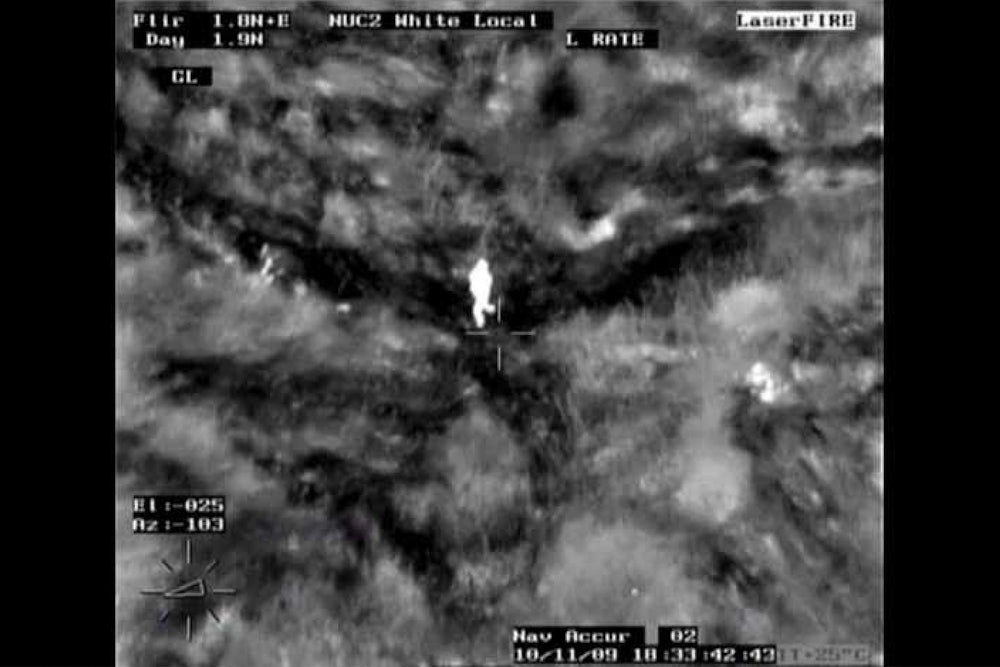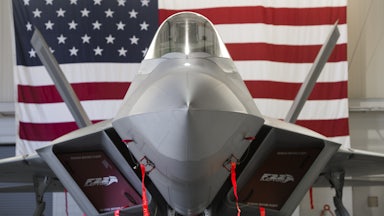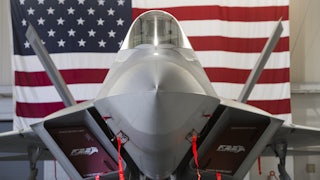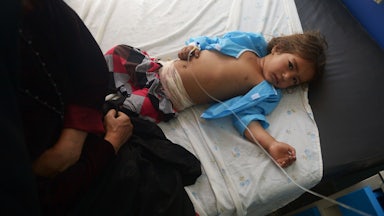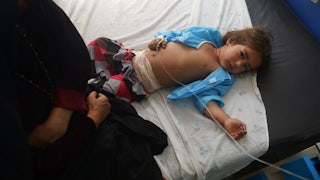In May 2013, Barack Obama delivered a speech at the National Defense University in which he defended the war on terror, then in its twelfth year. Though remembered as an antiwar candidate, Obama actually had never declared opposition to the war on terror itself. Rather, the problem, as Obama saw it, was that the United States had waged its war without regard for the law. He had taken pains to change this. As he proudly trumpeted in his speech, his administration “unequivocally banned torture, affirmed our commitment to civilian courts, worked to align our policies with the rule of law, and expanded our consultations with Congress.” The war on terror, previously tainted with the stink of illegality, had been cleansed.
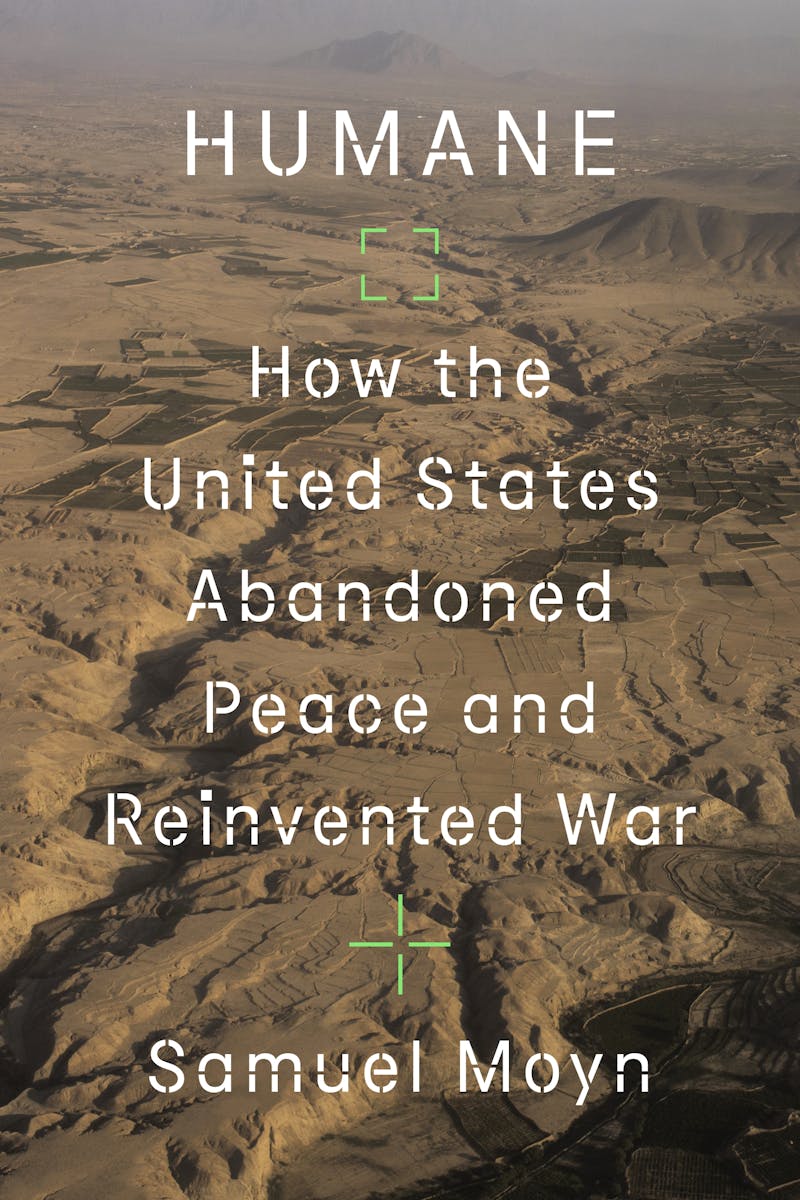
The president also proudly affirmed that he was fighting the war on terror humanely. The large numbers of boots on the ground that had defined the Iraq War, and which had resulted in the deaths of untold numbers of Iraqi civilians, had been replaced with unmanned aerial vehicles, better known as drones. “By narrowly targeting our action against those who want to kill us and not the people they hide among,” Obama avowed, “we are choosing the course of action least likely to result in the loss of innocent life.” Americans could rest assured that their president was defending them ethically.
In his new book, Humane: How the United States Abandoned Peace and Reinvented War, the Yale historian and law professor Samuel Moyn explores how American decision-makers, military officials, jurists, and activists developed what he considers a troubling obsession with “humane” war—wars in which the United States attempts to limit the suffering of troops and civilians. This focus may appear counterintuitive: If wars are fought, why not make them less destructive? But Humane makes the case that humane warfare brings its own set of hazards. The book reconstructs a centuries-old debate between those who insisted that war be fought humanely and those who were concerned that, by making combat more palatable, humane war would do little but promote endless conflict. In this way, Humane is a prehistory of our era, in which the precision drone strike has replaced massive aerial bombardment, small footprint Special Forces have replaced the ground invasion, and the United States remains entangled in wars around the world.
Moyn himself has not always identified humane war, or even war itself, as a major obstacle to peace; in the 1990s, at the beginning of his career, he was, briefly, a liberal internationalist who believed force was sometimes necessary to achieve greater ends. His argument in Humane articulates a disillusionment that many intellectuals underwent in the Obama era, as the war on terror dragged on, bringing loss of civilian life abroad and a vast surveillance apparatus at home, all under the guise of humanity. Moyn’s shift from liberal internationalist to critic of humane war reflects a broader awakening of a generation of American anti-imperialists, who have begun to question many of the premises that have guided U.S. foreign policy for decades.
Until relatively recently, debates about humane war were largely theoretical. For much of the twentieth century’s first half, the prospect of a war without brutality appeared remote. The carnage of World War I—the trenches of the Western Front, the Armenian genocide, the British blockade of the European continent—made clear to many contemporary observers that war could never be fought without enormous human cost; it could only be abolished. Peace was the goal. This was especially true in the United States, which in 1917 had broken 141 years of tradition by sending troops to fight a European war that many soon viewed as pointless and illegitimate. By 1933, “Americans could boast twelve million adherents to the peace movement and an annual combined budget of more than $1 million” for pro-peace organizations.
U.S. peace advocates considered international law an important mechanism for preventing conflict. Though the Senate famously refused to join the League of Nations, American elites nevertheless helped orchestrate the Kellogg-Briand Pact of 1928, which renounced “war as an instrument of national policy.” The pact infamously had no enforcement mechanism. Still, in the opinion of peace advocates like the political scientist Quincy Wright, the Kellogg-Briand Pact took the important step of formally and publicly aligning the U.S. government with the cause of global peace.
World War II annihilated the peace movement. The dream that rational exchange could avoid wars was dashed by Nazi Blitzkriege in Europe and Japanese surprise attacks in the Pacific. To the majority of observers, the war’s outbreak demonstrated that only force could tame geopolitics. For this reason, U.S. elites chose to pursue international order through armed domination of most of the world, establishing a vast network of bases across the globe. The Pax Americana that followed was a period of peace insofar as mass war did not break out between the great powers or tear across the European continent, but the United States frequently went to war, deploying troops to stamp out communism or overthrow leaders unfriendly to U.S. economic and strategic interests. As the Military Intervention Project at Tufts University has revealed, since the close of World War II, the United States has undertaken over 300 military interventions.
If World War II put the United States on a permanent war footing, its inhumanity simultaneously brought about attempts to mitigate war’s worst horrors. Most prominently, the Geneva Conventions of 1949 regulated the treatment of wounded troops, prisoners of war, and civilians, while the Nuremberg Charter of 1945 made crimes against humanity illegal. These measures established some of the principles of humane war, though they were rarely put into practice. For most observers, the prospect of genuinely humane war was not yet in sight.
The first three decades of the Pax Americana were notoriously violent, especially in Asia, a region in which the United States had long pursued a foothold. During the Korean War, the United States showed remarkably little regard for Korean life, engaging in scorched-earth and air campaigns that, Moyn recounts, reduced “every town and even village of note in the north … to smoking ruin.” The war brought about 3.5 million Korean casualties, making it “the most brutal war of the 20th century, measured by the intensity of violence and per capita civilian death.”
The savagery of the Korean War, however, didn’t stop the United States from fighting another barbarous ground war in Asia that had little connection to its vital interests. For much of the Vietnam War, U.S. forces killed civilians based “on the barest suspicion of Viet Cong involvement”; executed and tortured POWs; forcibly relocated villages; laced the countryside with land mines; made expansive use of napalm and phosphorus; and indiscriminately bombed North Vietnam, Cambodia, and Laos. While several of these activities were legal—there were no formal restrictions against aerial bombardment or napalm—many of them were not, to say nothing of the fact that all were immoral. By the time U.S. troops fully left Vietnam in 1975, millions of Vietnamese had perished in the war.
The escalation of the Vietnam War in the mid-1960s drew strong opposition from the American public—by 1968 the war was, Moyn notes, “terminally unpopular”—but the antiwar movement was largely concerned with the moral and legal basis on which the United States had entered the war, rather than with the atrocities that U.S. forces committed in the fighting. A turning point came in 1969, when the journalist Seymour Hersh broke the story of the My Lai massacre, which described a U.S. Army company’s murder of more than 500 South Vietnamese civilians. One of the most important responses to My Lai was written by Telford Taylor, a Columbia law professor, who earlier in his career had served as chief counsel at the Nuremberg Trials. Taylor’s 1970 book, Nuremberg and Vietnam: An American Tragedy, Moyn writes, “made allegations of war crimes ‘respectable’ by moving them from the far left to the liberal center.” Moyn maintains that Taylor’s book was so consequential because he was otherwise unwilling to criticize the U.S. military; without opposing the war itself, he urged other Americans to take a stand against its extraordinary brutality.
Soon after the war ended, a novel American coalition “concerned with the fate of the innocent in war” emerged. U.S. military lawyers formed a central part of this coalition, and in the late 1970s started to take up a novel legal framework dubbed “international humanitarian law,” which was embodied in the “Additional Protocols” to the Geneva Conventions, accepted in 1977. The Additional Protocols made three interventions: They “clearly formalized” civilian immunity; they prohibited “excessive” collateral damage; and they “called for precautions in targeting.” Taken together, the protocols “affirmed that the point of war was to weaken military capacities on the other side, absolutely prohibiting the direct targeting of civilians.” While the United States never ratified the Additional Protocols, by the 1980s the American military had in effect embraced them.
The Additional Protocols reflected what might be termed the “de-massification” of war that started after Vietnam. World War II, Korea, and Vietnam were “total wars,” involving the mass mobilization of society and the indiscriminate targeting of civilians, who produced the matériel that enabled battle. The public opposition to the Vietnam War, however, showed U.S. decision-makers that they could no longer rely on large-scale mobilization. If the United States was going to continue to dominate the world, it needed to “de-massify” its conflicts. In 1973, Congress refused to extend the draft. The military became an all-volunteer force, concluding a 33-year period in which ordinary Americans had been conscripted en masse to fight their nation’s wars.
From 1973 onward, America’s wars were fought only by those who volunteered to fight them, which both undercut the antiwar movement and changed Americans’ relationship to their armed forces. In short, Americans no longer needed to worry about being forced to die in foreign lands for unclear purposes. The AVF’s advent also began to transform the “American Way of War.” Whereas the United States had previously relied, as the historian Rose Lopez Keravuori has summarized, on “large masses of forces” using “overwhelming power to destroy the enemy,” after Vietnam the U.S. military started to assert itself through air power, Special Forces, and the system of international bases it had developed after World War II.
The seeds of humane war were thus planted, though they would only bear fruit during the Gulf War of 1990–1991. This war, unlike any previous U.S. war, was carried out with a phalanx of military lawyers at the ready. As Moyn highlights, lawyers rapidly “became fixtures of air operations centers, advising when dual-use targets—with both civilian and military purposes—were fair game and when limits on disproportionate collateral harm were likely to be violated.” For the first time in American history, the military “accepted an unprecedented intrusion of legality into fighting.” Indeed, lawyers remained crucial participants in all post–Gulf War U.S. conflicts. Combined, the presence of lawyers and the de-massification of war persuaded American elites that their nation could dominate the world ethically, with little cost to most of them.
The initiation of the war on terror after the attacks of September 11, 2001, revealed a particularly troubling feature of so-called humane war: that it could go on for much longer than a mass war.
Soon after the war on terror began, the news program 60 Minutes II revealed photos of U.S. guards torturing detainees at Abu Ghraib prison in Iraq, engendering an outcry from Americans critical of the war. But instead of pulling out of Iraq or ending the war on terror, the George W. Bush administration used lawyers like Jack Goldsmith of the Office of Legal Counsel to bring it “within the pale of legality.” And the administration was successful, at least in part. Its efforts attenuated “the harshest methods of interrogation” and ensured that certain protections were granted to combatants captured in battle.
These accomplishments, Moyn writes, “cleansed” the war on terror “of stigma” and had the ironic impact of leading the country into “a war that became endless, legal, and humane.” When Barack Obama assumed office in 2009, he continued the humanization process begun under Bush. Specifically, he made extensive use of drones and Special Forces, which his lawyers deemed humane, effective, and legal. Thus Obama approved manifold precision drone strikes throughout the global south—in Afghanistan, Iraq, Pakistan, Somalia, and Yemen—and deployed U.S. Special Forces around the world. Famously a graduate of Harvard Law School, Obama established “a lawyerly institutional process” to determine who to target; each week, he went “over ‘kill lists’ that he personally vetted.” In this way, the president personally oversaw the execution of thousands of people, many of whom were only tenuously connected to U.S. enemies.
By the time he left office, Obama had midwifed the new, de-massified, and humane American Way of War that had been gestating for years. And many in the liberal establishment lined up behind him. As the Brookings Institution’s Daniel L. Byman affirmed in a 2013 article titled “Why Drones Work,” Obama’s use of drones hurt “terrorist” groups and gave “Washington the ability to limit its military commitments abroad while keeping Americans safe.” In The Atlantic, the international lawyer Michael W. Lewis insisted, as his piece was subtitled, that drones were “Actually the Most Humane Form of Warfare Ever.” For its part, The New York Times published an article in which experts made “The Moral Case For Drones.”
But not everyone paid obeisance to Obama. David Cole, the legal director of the American Civil Liberties Union, attacked the administration in The Nation for its “disturbing practice” of using drones to “kill thousands of our ‘enemies,’ and lots of civilians, many of them far from any battlefield.” In his 2015 book, Power Wars, Charlie Savage, The New York Times’ Washington correspondent, illuminated the expansion of executive power and surveillance networks that fueled the Obama-era national security state. Critics worried that Obama was institutionalizing a way of war that accorded himself and future presidents a significant amount of unaccountable power. And they were right; as many of them feared, the powers Obama wielded passed to a particularly reckless successor. Unsurprisingly, Donald Trump made extensive and expansive use of them, keeping the structure of the humane, light-footprint, but unconstrained approach to war the United States had embraced under Bush and Obama.
It was the turmoil of the Bush and Obama eras that reshaped Moyn’s own politics. Ideologically, Moyn started his career a liberal internationalist—in Humane, he writes that, as a young White House intern in the late 1990s, he believed the 1999 NATO intervention into Serbia was “the final violence necessary to put right a globe that had been disfigured by the necessities of the Cold War but was now on the brink of peace.” But the failures of Afghanistan, Iraq, and the war on terror writ large converted him to an avowed anti-imperialist position, and he began to write more and more for the public. Whereas Moyn’s early works were decidedly academic—a book on the French Jewish philosopher Emmanuel Levinas, another on Holocaust memory in postwar France—in 2010 he published The Last Utopia: Human Rights in History, which insisted human rights were a relic of the 1970s that “have done far more to transform the terrain of idealism than they have the world itself.” In 2018, Moyn expanded upon his criticism of human rights to argue, in a book of the same title, that they were Not Enough—that human rights needed to be bolstered with a commitment to material equality and economic justice.
Humane is a continuation of Moyn’s decade-long critique of human rights and the liberal ideology that undergirds them. But, unlike his earlier books, Humane expresses a more avowed anti-imperialism, looking specifically at the misplaced idealism used to justify American Empire to the nation’s elites. Moyn’s anti-imperialism emerged as a younger generation of thinkers, who came of age after the U.S. invasion of Iraq, were developing their own critiques of American power; many, in fact, were students at Columbia, where Moyn then taught. By 2017, “The Disillusionment of Samuel Moyn” was notable enough to warrant a feature in The Chronicle of Higher Education, which traced the connections among the Moyn Circle, a group that includes the historians James Chappel, Ana Keilson, Thomas Meaney, and Daniel Steinmetz-Jenkins, as well as David Marcus, the literary editor of The Nation; Timothy Shenk, the co-editor of Dissent; and Stephen Wertheim, a founder of the Quincy Institute for Responsible Statecraft who now works at the Carnegie Endowment for International Peace. In Humane, Moyn thanks Meaney, Shenk, and Wertheim for their notes, and cites Wertheim’s work several times.
Several of the circle put analysis of U.S. empire front and center, forming a loose network of left-wing critics of U.S. foreign policy that embraced an unsparing intellectual style. Many in the group published well-honed eviscerations of prominent figures in pugnacious little magazines (as one former student commented in the Chronicle article, Moyn made it “OK to really shred … the book you’re reviewing”). Moyn served, the Chronicle noted, “as a model and magnet for a generation of younger historians and public intellectuals” in increasingly angering times.
In Humane, Moyn’s wide reading in North Atlantic philosophy, legal theory, and criticism enables him to reconstruct a centuries-old debate that most scholars have downplayed or ignored. As he traces the rise of humane war, he also unearths its early critics. Moyn begins the book with the Russian novelist Leo Tolstoy, who worried that two risks accompanied the project to humanize war. First, there was the risk that humanizing war encouraged people “to tolerate an enduring evil” instead of seeking its end. Second, there was the risk that people would “believe that striking a blow against the cruelty of a practice made their continuing involvement in it noble.” Humanizing war, Tolstoy maintained, was likely to make war honorable and peace scarce.
And Tolstoy was not a voice in the wilderness. In the wake of World War I, as Moyn notes, the British novelist H.G. Wells expressed the opinion of many when he affirmed that attempts to humanize war were “sops to humanity, devices for rendering war barely tolerable to civilized mankind, and so staving off the inevitable rebellion against its abominations.” These early warnings make it difficult to argue that our “forever war” was unforeseeable. For as long as the idea of humane war has existed, there have been prominent critics who worried about the potential connections between humanization and permanent conflict.
Nonetheless, Moyn’s narrow focus on the law sometimes leads him to mischaracterize parts of his story. Take, for example, his reflections on American air power in World War II. Moyn finds it puzzling that after the war “no international lawyers rose to prominence in ethical resistance to [the] urban holocausts” caused by aerial bombardment, suggesting that this was “because the law gave them no basis to do so.” But this misses what was going on at the time. In fact, there were groups both within and outside the military who believed that aerial bombing campaigns were humane. In 1943, for instance, Henry Harley Arnold, the chief of the Army Air Forces, referred to the precision strategic bomber as “the most humane of all weapons” because it had the potential to make ground war a thing of the past. After the atomic bombing of Hiroshima, one high-ranking air force officer went so far as to write “that the accuracy with which this bomb was placed” demonstrated that it was not an example of “wanton, indiscriminate bombing,” but was rather the embodiment of precision—and, by implication, humane—warfare.
The willingness of an air officer to present an atomic bombing as an instance of humane warfare indicates that U.S. elites have been deceiving themselves about the “humanity” of their wars for far longer than Moyn argues. Delusions of American innocence—reflected in the idea that even atomic bombings could be humane—were baked into U.S. dominance from its beginnings. It is wrong to claim, as Moyn does, that Americans “embraced global order … as ardent foes of humane war.” In many cases, the opposite is true.
Relatedly, Humane implies that the arguments of humane war’s advocates were the primary reason the United States adopted the tactics of humane war. But such arguments found purchase only when other, more causally important transformations took place—when the advent of new technologies, domestic coalitions, and state institutions encouraged and enabled the United States to dominate the world through light-footprint and “precision” wars. Furthermore, several countries, including Azerbaijan, Iraq, Nigeria, Saudi Arabia, and Turkey, have used drones without making any pretense of practicing humane war, which suggests that other factors besides the intellectual are driving the use of this especially effective technology.
A fundamental assumption of Humane is that arguments for humane war made U.S. imperialism palatable to the American public. This is doubtful: The public rarely places foreign policy at the center of its concerns. Depressingly, if consistently, the American public cares about war when it affects them (as it did during Vietnam) or when criticisms of war can be used as a partisan cudgel (as they were during Iraq). While it’s true that arguments for humane war helped lawyers, politicians, and military officers clear their consciences, it’s unclear whether the public ever really cared one way or the other.
Intellectually, Moyn’s criticisms of humane war are spot-on. But I can’t help but conclude that his focus on humane war is somewhat behind the times. Arguments for humane war no longer occupy the center of political debate as they did in the Bush and Obama years; Trump’s vulgarities have given the lie to the idea that the United States is an exceptional nation able to ethically govern the world. The recently elected Joe Biden barely mentioned law, and said nothing about humane conflict, in his February speech addressing U.S. foreign policy. Critiques of humane war simply do not speak to the new era of great power competition, which pits the United States and its allies against China, Russia, and other authoritarian powers. Nor do they directly address the major, and consistent, reasons the United States acts in the world as it does: the desire and ability to dominate others.
It’s heartening that the intellectual energy among critics of American power has shifted from lambasting the tactics of American warfare to advocating for strategic restraint. Moyn himself endorses this transformation, and in Humane he affirms that observers must focus less on how war is fought and more on whether it is fought. The concern with humane war paved the way for the more ambitious demands anti-imperialists are making today. For the first time in almost a century, we can dare to imagine peace.
